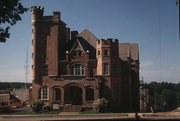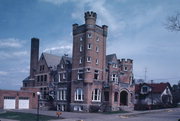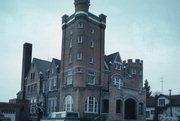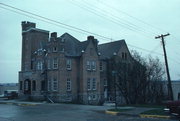Property Record
215 E 5TH ST
Architecture and History Inventory
| Historic Name: | Clark County Jail |
|---|---|
| Other Name: | Clark County Jail |
| Contributing: | |
| Reference Number: | 3319 |
| Location (Address): | 215 E 5TH ST |
|---|---|
| County: | Clark |
| City: | Neillsville |
| Township/Village: | |
| Unincorporated Community: | |
| Town: | |
| Range: | |
| Direction: | |
| Section: | |
| Quarter Section: | |
| Quarter/Quarter Section: |
| Year Built: | 1897 |
|---|---|
| Additions: | |
| Survey Date: | 1984 |
| Historic Use: | jail/correctional center/prison |
| Architectural Style: | Romanesque Revival |
| Structural System: | |
| Wall Material: | Brick |
| Architect: | STOLZE AND SCHICK |
| Other Buildings On Site: | |
| Demolished?: | No |
| Demolished Date: |
| National/State Register Listing Name: | Clark County Jail |
|---|---|
| National Register Listing Date: | 12/8/1978 |
| State Register Listing Date: | 1/1/1989 |
| National Register Multiple Property Name: |
| Additional Information: | A 'site file' exists for this property. It contains additional information such as correspondence, newspaper clippings, or historical information. It is a public record and may be viewed in person at the Wisconsin Historical Society, Division of Historic Preservation. 5 STORY TOWER. ROUND ARCHES. SEGMENTAL ARCHED ENTRY. CRENELLATED TOWERS. Architects from La Crosse evoked a medieval dungeon in their design for the Clark County Jail, a long-popular way of conveying a prison’s purpose: punishment. The core of the imposing Romanesque Revival building is a two-and-one-half story block with a segmentally-arched porch. Flat lintels of Bedford limestone link the windows, forming ribbons along the buff-brick walls. The hipped roof is complicated by numerous wall dormers and by the two towers flanking the entry porch on the main facade. The shorter, hexagonal tower terminates in a crenelated parapet, and the five-story, square behemoth features a cylindrical bartizan. 2016- "The LaCrosse architectural firm of Stozie & Schick utilized the Richardsonian Romanesque style for the 1897 jail. The structure not only housed prisoners but also provided a finely appointed Victorian residence for the Sheriff and his family. The crenellated battlements of the east and west turrets provided an elevated platform for country sheriffs to monitor crowds that assembled during the milk riots of the 20s. The county discontinued use of the sheriff's residence in 1974 and the jail portion in 1978. Shortly thereafter the 1897 Clark County Jail Museum took over the building." -"Neillsville, Wisconsin Historical & Architectural Tour", Prepared by the Neillsville Historic Preservation Commission, 2016. Functionally, the building is divided into two seemingly incompatible parts: a jail and a private home. Along the rear (north side) of the building runs the jail section, a thirty-foot-long polygonal apse, gabled at each end, housing a cell block for up to twelve men on its first and second floors. Visitors can see the original iron cells. In addition, the jail had an isolation cell and a “drunk tank.” The architects designed the third floor with amenities like windows to house female prisoners, but there is no record that women were ever actually incarcerated here. The building’s front portion contained commodious living quarters, including a parlor, sitting room, dining room, kitchen, and five bedrooms. These accommodations, designed to meet the needs of a Victorian middle-class family, were incorporated into the jailhouse because the county board of supervisors required the sheriff and his family to reside on site. Moreover, as an economy measure the supervisors required the sheriff to provide meals to the prisoners. This became the unpaid duty of the sheriff's wife. Her kitchen was entered through the sheltered English basement entrance at the east elevation. |
|---|---|
| Bibliographic References: | MARSHFIELD NEWS HERALD 5/18/1996. Neillsville Clark County Press 5/19/1999. Neillsville Clark County press 5/15/2002. Buildings of Wisconsin manuscript. |
| Wisconsin Architecture and History Inventory, State Historic Preservation Office, Wisconsin Historical Society, Madison, Wisconsin |





